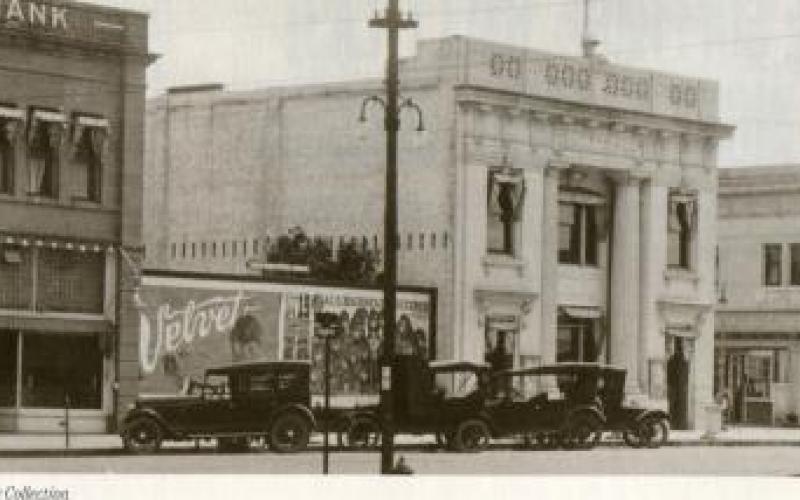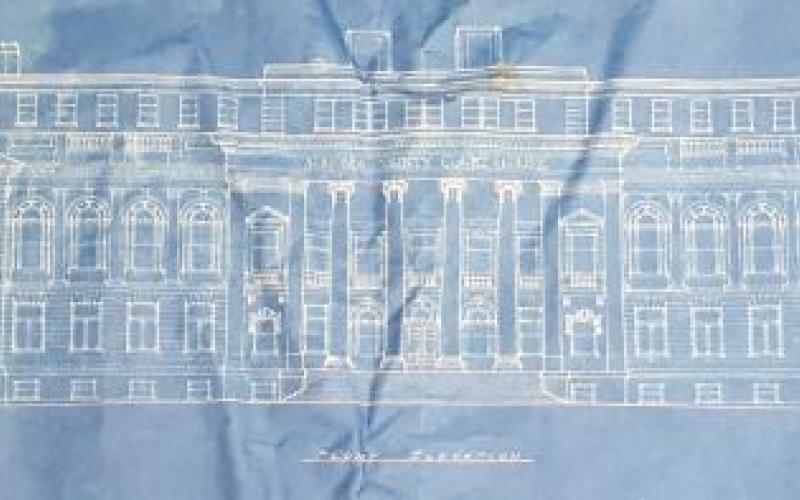Local History and Genealogy Notes
Juilliard Park and the Landscape Architect Who Designed It
Posted on August 07, 2017
The Historical Society of Santa Rosa recently informed its members by way of a Face Book post that the City of Santa Rosa's Recreation and Parks Department is conducting a pond resurfacing project at Juilliard Park. Many likely know that property upon which the park sits was given to the City of Santa Rosa by Frederic A. Juilliard in 1931. If you've been to the park it's hard to miss the large boulder with the plaque stating this.
At the time, the 9-acre parcel contained the Juilliard home, built in 1872, outbuildings, fruit and shade trees. A condition of the gift was that the City of Santa Rosa remove the residence and other structures and develop the property for use as a public park. Planning for the park began in 1932 and completed in 1938 - although I have yet to find an exact dedication date.
Funding for the park came from the City of Santa Rosa Relief Fund and at least two federal programs: the Civil Works Administration and Works Progress Administration. What people are probably less familiar with is the landscape architect who designed the park - Howard Gilkey.
Although Howard Gilkey (1890-1972) was born in Iowa, he spent his teens living in Santa Rosa on Morgan Street with his parents, Barton and Laura Gilkey, his sister Esther and grandmother, Harriett Wetmore. While attending Santa Rosa High School, Howard worked for Luther Burbank. After graduating he attended UC Berkeley where he had the unique opportunity to serve as an assistant to a landscape designer who was superintendent of horticulture for the Panama Pacific International Exposition in 1914. Gilkey would later be hired to work on the 1939/40 Golden Gate International Exposition at Treasure Island.
Gilkey graduated from Berkeley in 1916 and took a job at Mills College where he taught landscape gardening. In 1921 and 1922, he was city park engineer and acting city planning engineer for the City of Oakland. One of Gilkey's most notable projects completed while with the City of Oakland is the Cleveland Cascade project near Lake Merritt. To learn more about this amazing historic site check out Adrienne Schell's blog post "Oakland Landscape . . . Gilkey's Vertical Grandeur"
Other examples of Gilkey's work during the 1920s include designs for Mills College, St. Mary's College and the Woodside Estate of Mortimer Fleishhacker. In the early 1930s, Gilkey served as a work-relief employee of the WPA and supervised 3,500 people engaged in the renovation of Golden Gate Park.
It was also during the 1930s that Gilkey returns to Santa Rosa where he designed Burbank Park at the Santa Rosa Junior College as well as Fremont and Doyle Parks and of course Juilliard Park.
An impressive Wikipedia entry exists for Howard Gilkey which I drew upon for this story. However, the contributor makes no mention of Gilkey's work in Santa Rosa. For that, I relied on back issues of the Press Democrat as well other sources such as Bill Montgomery.
Bill Montgomery, retired Santa Rosa Recreation and Parks deputy director, has completed quite a bit of research on Gilkey and is known to take on the persona of Howard Gilkey while leading tours of Juilliard Park. Gilkey is just one of many "characters" played by Bill who is a volunteer member of the Santa Rosa Rural Cemetery Preservation Committee.
As Santa Rosa's 2018 sesquicentennial approaches, there is an opportunity to celebrate Howard Gilkey and the parks he designed which are such an important part of the city's identity. As for Juilliard Park specifically, it may too be celebrating an anniversary in 2018 - it's 80th birthday!
A Photo of Three Petaluma Women and So Much More
Posted on March 08, 2017
In honor of International Women's Day I'm posting a photo from the Sonoma County Library's collection. According to the cataloging notes this picture was taken in 1958 and shows Ruth Snodgrass, Jessie Mitchell and Betsy McLaughlin.
Additional notes include that Ruth Snodgrass was secretary to cattle dealer Chris Beck. Ruth, and her husband Harold, lived at 856 B Street, Petaluma. Jessie Mitchell owned Petaluma Travel Agency on Kentucky Street in Petaluma and Betsy McLaughlin, and her husband Bob, owned McLaughlin's Jeweler's also on Kentucky Street. The women are standing in front of a National Business Women's Week poster.
National Business Women’s Week began in 1928. The first annual observance was held in April 15-22, 1928. President of the National Federation of Business and Professional Women’s Clubs, Lena Madesin Phillps, opened the week with a nationally broadcast speech from New York City. She stated that the purpose of the week was “to focus attention upon a better business woman for a better business world.”
Nowadays, National Business Women’s Week occurs during the third week of October. Anything planned for 2017 involving Sonoma County women?
If it wasn’t for the photo of Ruth, Jessie and Betsy I might not have been prompted to research National Business Women’s Week which led me to learn more about the National Federation of Business and Professional Women’s Club AND discovering who Lena Madesin Phillilps was. A fascinating and inspiring woman. That’s an understatement.
Google Lena’s name and you will be amazed at what you find. Sonoma State University Library has a copy of A Measure Filled: The Life of Lena Madesin Phillips drawn from her autobiography.The papers of Lena Madesin Phillps (1881-1955) are housed at the Harvard University Library.
Once again, I’ve been led astray all because of one photo. Astray might not be the right word – educated is more accurate. Lifelong learning on the job. Can’t beat that!
Turton, Not Dolliver, Designed the 1913 Santa Rosa City Hall
Posted on January 23, 2017
For those of you who read my last blog "Interesting Discovery at the Sonoma County Archives" you know that I claimed that J.W. Dolliver designed Santa Rosa's City Hall. Not true. Dolliver did in fact bid on the project, but it was Napa architect, Luther Turton (1862-1925) who got the contract. This I learned from Jeff Elliott, a local historian and regular visitor to the Sonoma County History & Genealogy Library. Jeff has his own history blog. Check out his latest post http://santarosahistory.com/wordpress/2017/01/our-forgotten-city-hall/ . A very interesting read!
Thank you Jeff. We will now up date our cataloging notes for the few photos in the Library's collection of the Santa Rosa City Hall, that stood on Hinton Avenue between 1913 and 1969.
Interesting Discovery at the Sonoma County Archives
Posted on January 18, 2017
The Sonoma County Library was officially designated the official archive for the County of Sonoma and the City of Santa Rosa in 1965 by a joint resolution. Today that Archive is located about nine miles east of downtown Santa Rosa and is contained within a 3,800 square foot warehouse. It is not climate controlled.
Although many of the materials housed at the Archive are accessible via the Sonoma County Library catalog, many are not. To fully realize the value of this amazing treasure trove an updated inventory is needed. As is funding for a new facility and dedicated staffing.
This is what was going through my mind Tuesday morning as I came across a set of architectural drawings prepared by E. Geoffrey Bangs in 1945 for the Sonoma County Board of Supervisors for a third story addition to the courthouse. As far as I can tell the Library has no record of these drawings. Like some many things at the Archives, I just happened to stumble across them while looking for something else. As the photos reveal, the drawings are not in the best condition. At some point they got wet which explains the rippling.
Using the Sonoma County Library's edition of Newspapers.com, I learned that Bangs' plan provided for a total of 19,000 added square feet, 15,000 of which would be used for offices, and two elevators. The addition was designed with a light steel frame supporting the floor and roof. This light type of structure was considered not only economical, but permitted holding the addition back from the face of the main building, "thus avoiding any aesthetic problems or the need for glorifying a purely utilitarian structure." (Petaluma Argus Courier, July 17, 1945)
Further research lead me to the UC Berkeley Environmental Design Archives and the E. Geoffrey Bangs (ca. 1893-1977) Collection. The finding aid for this collection states that E. Geoffrey Bangs was a Bay Area architect and a graduate of University of California, Berkeley. He earned his bachelor’s degree in 1914 and obtained his master’s the following year. His early career was spent working in the office of John Galen Howard. Bangs designed many public buildings and large-scale public housing projects in Northern California. His projects included UC Berkeley’s Lewis Hall, the Contra Costa Hall of Records, and the courthouses for Shasta and Butte counties.
The E. Geoffrey Bangs Collection consists almost entirely of black and white photographs documenting numerous Bay Area residential and commercial buildings. The photographs also include images of UC Berkeley buildings. Some of the photographs in the collection may be for a photo essay entitled "Portals West: A Folio of Late Nineteenth Century Architecture in California." The collection also contains a typescript of this book which was published by the California Historical Society. The Sonoma County History & Genealogy Library has a copy of this book in its rare room (Annex Rare 720.9794)
As we know a third story was never added to the courthouse. Why this was the case and why the Board of Supervisors sought to engage Bangs are questions I'm left with.
It may be that the Board of Supervisors decided to redirect funds to pay for the design and construction of one or more war memorial buildings.
Why Bangs? Well certainly it was not the first time a San Francisco based architect was involved in a Sonoma County civic project. For example, J.W. Dolliver, a prominent Bay Area architect designed both the Sonoma County Courthouse in 1910 and the Santa Rosa City Hall in 1912. Dolliver actually lived in Kentfield, but his offices were in San Francisco. Perhaps the Board of Supervisors would have called upon Dolliver again for the third story addition project if he hadn't died in 1927.
Again according to newspaper accounts, Bangs was involved in at least one more Sonoma County project. In March of 1946, the Board of Supervisors approved plans prepared by Bangs for a new county detention facility that met all of the requirements of the California Youth Authority and would be located on the grounds of the Sonoma County Hospital.
Would a visit to UC Berkeley tell us more? At the very least the Environmental Design Archives should be made aware of this "find" so that they can update their cataloging notes to include reference to Bangs' work in Sonoma County. Speaking of cataloging, the Bangs' drawing can now be added to the Library's list of holdings. As stated earlier, an updated inventory is need. Until a dedicated funding source is identified, we will have to make do with the one item at a time approach.
Wednesdays are for Women: Dagny Juell
Posted on October 05, 2016
Dagny Juell joined the staff of the Santa Rosa Free Public Library in 1924, after working two years as a high school librarian. She was born in Minnesota in 1893 to Norwegian immigrants Niels and Petrea Juell. By 1905 Dagny had moved to Santa Rosa with her parents and brother and sister and was living on Monroe Street. Neils Juell was the proprietor of Juell’s Drug Store.
Miss Juell took charge of the newly created children’s room at Santa Rosa’s Carnegie Library in 1925. The room started with approximately 3,000 books, but quickly grew to 13,000 volumes.
In addition to her position as children’s librarian, Dagny Juell served as Assistant City Librarian and was one of the founders of the Association of Children’s Librarians in Northern California.
Dagny retired in 1959 before the Carnegie Library was demolished and died in 1964, two years before construction started on the “new” library. She is buried at Santa Rosa Memorial Park.
Three generations of Santa Rosans received books from Miss Juell and she was highly regarded among other children’s librarians throughout the state.
The children’s room at the Santa Rosa Central Library is named the Dagny Juell Library for Boys and Girls.






